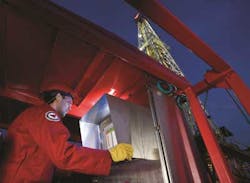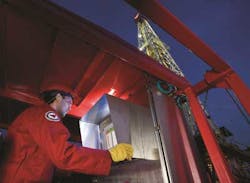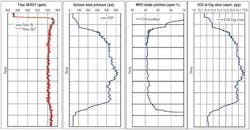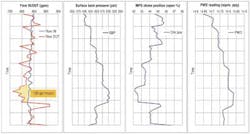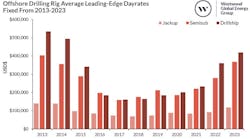Don Hannegan
Tim Dunn
Weatherford
Dennis Moore
Marathon Oil Corp.
Ken Gray
University of Texas at Austin
Closed-loop cementing (CLC) is considered a fringe benefit of managed pressure drilling (MPD). However, CLC has the capacity to improve cementing success and performance over the life of the well. In deepwater wells where high-pressure/high-temperature (HP/HT) conditions and narrowdrilling windows present challenges to conventional cementing methods, CLC offers a set of capabilities that are just beginning to be explored.
Cementing extremes
In well construction, isolating potential flow zones in deep, fault-segmented HP/HT basins can present many difficulties, including rapid development of extreme overpressure, elevated temperatures, and tight drilling windows between formation pressures and fracture gradients. For cementing operations, the challenges include a lower than predicted leak-off test (LOT) value, the need for higher mud weights than estimated, and the risk of inducing fractures during pre-flush and slurry displacement.
Cementing problems often begin with surge pressures when running casing. These surges can fracture or destabilize the formation and initiate slurry losses that result in the top of the annular cement column being lower than calculated.
MPD provides a way to manage cementing by precisely measuring flow in and out of the well in real-time, acquiring actual downhole pressures, performing dynamic formation integrity tests (FITs), and controlling wellbore pressure using a surface choke. The ability to conduct frequent dynamic FITs while drilling in trouble zones may benefit cement and casing planning success in extreme hole environments.
CLC applications
In the context of API standards (API 65, Part 2,Isolating Potential Flow Zones during Well Construction), CLC addresses a spectrum of compliance concerns. Using dynamic FITs, CLC makes it possible to verify formation containment capability prior to running casing. Cement placement standards are addressed with real-time fluid dynamics management and detection of induced fractures. MPD also can ensure accurate placement of balanced plugs by using backpressure to achieve a more consistent annular pressure and to enhance the setting environment.
Applied to cementing for well construction and P&As, MPD methods and technology enhance both the execution and evaluation of cementing operations by providing more control, more accurate data, and additional parameters to consider.
MPD improves the chances of getting a good cement job by reducing pressure cycling, improving the accuracy of downhole calculations and planning data, and optimizing casing running. Closed-loop cementing makes it possible to respond to events in real time, impose or remove annulus pressure as desired, enhance documentation, and improve onsite and offsite monitoring.
Better data; better planning
Successful zonal isolation requires a plan to monitor and control static and dynamic fluid pressures in thedrilling fluid column with the objective of maintaining equivalent circulating density (ECD) within appropriate limits (API 65). Even the cement job design and execution plan may not deliver the desired results due to inadequate or inaccurate input.
Engineers simulate ECD, flow characteristics, and other factors to predict how to place cement effectively. These calculations use fluid returns, pump rates, lift pressure, plus the volumes and densities of the cement, spacer, and mud.
A closed-loop MPD circulating system acquires more data with greater accuracy to improve input for hydraulics modeling, cementing, and wellbore behavior predictions. In cementing applications, this provides precise, real-time measurements of flow in and out of the wellbore, easy application of dynamic FITs, and allows accurate calculation of downhole pressures. The result is an increase in the ability to control cement placement and hold it in place during setting while managing the pressures imposed on the formations.
FIT and LOT requirements
Experience shows that lost circulation is the root of many offshore drilling loss-of-well-control incidents. Lost circulation before, during, or soon after primary cementing can reduce the overbalance across potential flow zones, which can result in the slurry not reaching the designed TOC depth, or a reduction in the drilling fluid column. The result of these shortened columns is reduced hydrostatic head insufficient to control formation pore pressures.
Lost circulation can be greatly reduced using FIT and LOT measurements to determine whether the hole has sufficient integrity to contain pressures generated by drilling, casing, and liner setting operations. FITs, which test the formation to a specific pressure, and LOTs, which test the formation to failure, typically are viewed as types of casing shoe tests, pursuant to API Standard 65. Most governmental regulatory organizations maintain criteria regarding verification of casing shoe integrity.
However, the casing shoe may not be the weakest point in the wellbore. That failure point may be encountered while drilling at a depth well below the last casing shoe.
A conventional static FIT, which applies surface pressure on top of a column of mud, exposes the wellbore to a different pressure profile than that experienced during cementing. A dynamic FIT is a better indicator of the pressure profile during cementing.
Dynamic FITs
Dynamic FITs can provide valuable information to cementing simulator models and can lead to adjustments in the planned cementing program. They also reduce the risk of a blowout while drilling by providing information about the formations drilled since the last casing string was set and static shoe test was conducted.
In operations where lost circulation material (LCM) may have added to uncertainty about the fracture gradient, dynamic FITs may help quantify the effect of LCM and other wellbore strengthening techniques. This could be valuable for drilling HP/HT wells that go through depleted zones or weaker formations, and may even eliminate a contingency casing string.
Dynamic FITs are done with rig pumps through the bit, and can be done while rotating the drillstring or even while drilling. The test gradually increases pump speed, and thus ECD, until the desired pressure is reached. A pressure-while-drilling (PWD) tool helps confirm and calibrate the hydraulics model, which can then be used to calculate ECDs at points of interest through the annulus. A dynamic FIT done this way does not require an MPD equipment package.
A dynamic FIT that imposes surface backpressure while circulating has an annular pressure profile that more closely approximates the one during drilling and cementing compared to a static test using surface casing pressure alone. Although it does not yield the same pressure profile that the wellbore will be exposed to during cementing or while drilling ahead, it still can yield valuable information.
Dynamic FITs planned with directional tools in the hole should anticipate the rates required to ensure they do not exceed the allowable operating window of those tools.
Since the structural integrity of a wellbore can change with each formation encountered and each foot drilled, conducting FITs before and after drilling critical zones appears to be a best practice. This helps ensure that the wellbore can withstand the surge pressures associated with subsequent casing running operations and the dynamic pressures predicted for cementing operations.
The ease of executing dynamic FITs supports their use in critical zones as opposed to making the usual assumption that the weakest point coincides with the casing shoe depth. Dynamic FITs contribute to the drilling and cementing best practice of maintaining a stable wellbore with no gains or losses.
Well control also benefits from dynamic FITs. Underground blowouts while drilling result from insufficient kick tolerance. If leak-off occurs before the desired FIT value is achieved, an underground blowout potential can be identified and avoided by reevaluating kick tolerance and the well plan.
Several things beyond fracture initiation/reopening pressure should be considered if the operator's specified or expected value FIT is not achieved. There must be a physical explanation for the rock failure and the operator's procedure for arriving at the expected/specified/desired FIT value must be considered in an effort to identify the root cause and potential impact on plans for subsequent drilling, casing, and cementing.
Case study 1
The following case history illustrates how the success of MPD constant bottomhole pressure (CBHP) methods in narrow or relatively unknown drilling margins can also apply to cementing operations. In this case, CLC was used primarily to maintain ECD within a very narrow margin during cementing operations.
Previous North Sea MPD experience led to selection of CBHP to drill the 12¼-in. and 8½-in. sections of the subject well while maintaining the EMW between 11.8 and 12.5 ppg at total depth. In this narrow drilling window, CBHP used a lower mud weight by managing downhole pressure using the combined effects of ECD and surface backpressure (SBP). The risk of testing the formation boundaries was significant because of the possibility of sticking the drillstring at the lower limit or fracturing the formation at the higher limit.
The lower MPD mud weight used in liner running and cementing led to the development of a new cementing program using SBP applied by MPD to minimize BHP fluctuations throughout the sequence of operations. This involved discrete phases of circulation with different fluids using mud pumps and the cement unit. The complex nature of the operation led to modeling of the MPD requirements in advance, and SBP values were calculated to produce a series of manual inputs for each step in the program.
The cementing operations met the objective of maintaining the casing shoe pressure in the range of 12.10 to 12.30 ppge. This was done by adjusting the dynamic SBP in sync with the density and circulating rates of the spacer, lead and tail slurry cement mixtures. This kept the casing shoe ECD consistently within the desired range.
Case study 2
A dynamic FIT by varying pump speed replicated the ECD profile that the wellbore would be exposed to during cementing, and enabled the operator to confirm that the formations would withstand those stresses before penetrating the producing zone. Adjusting pump speed during the cement job allowed placing the cement without an influx from the lower zone and without losing returns to a zone at the casing shoe with a lower frac gradient than the mud weight required to prevent flow from the target formation.
CLC outlook
Application of MPD principles to cementing operations has been done for several years but is still in its infancy. It has been used where an MPD kit was not otherwise required or where the MPD kit was already on the rig for other drilling purposes. Both applications have yielded noteworthy success.
Much of the vision for the potential for CLC on deepwater HP/HT wells has yet to be proven with practical field applications. CLC may help post-cementing operations, such as foam designs where pressure is held on the annulus during WOC time. On floating rigs, closing the MPD choke after displacement may help keep the cement in place.
While some of these CLC concepts are unproven, experience and the size of the prize indicate further study and field trials would be worthwhile.
